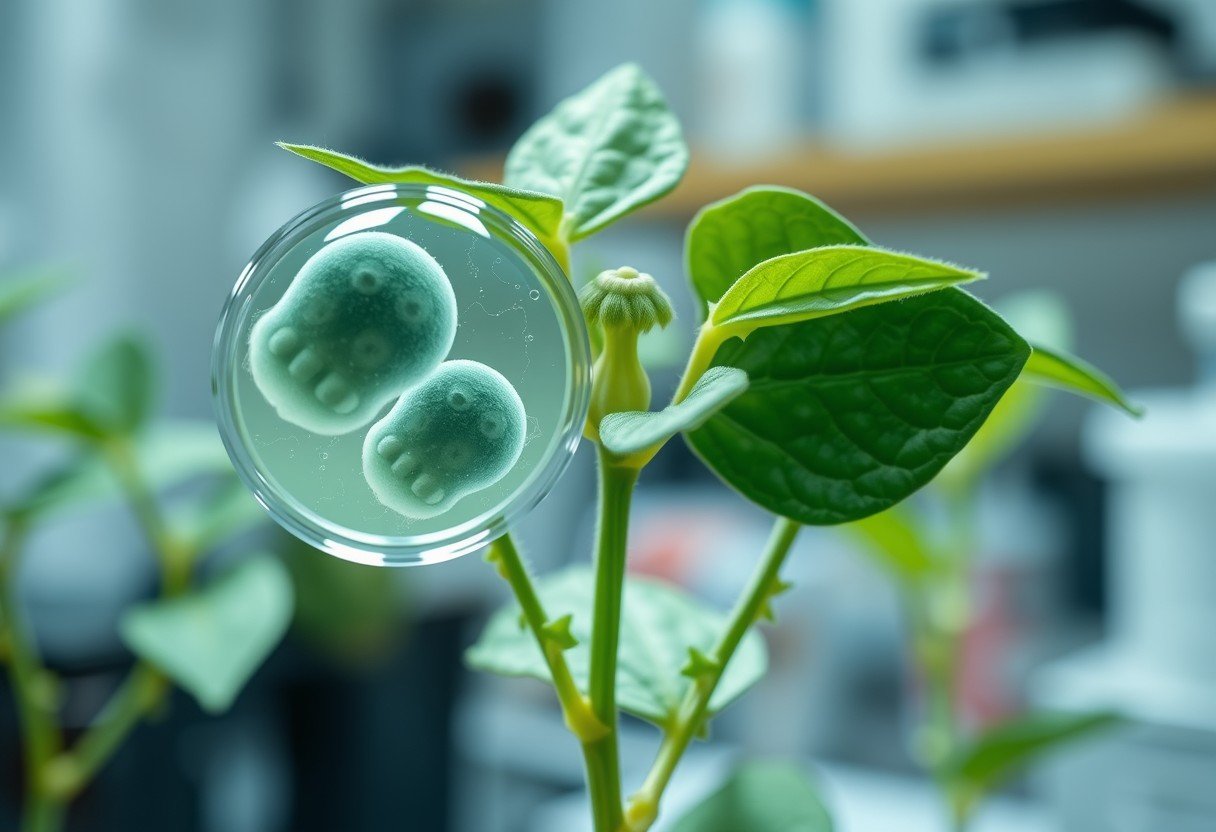Have you ever wondered how hybrid plants create the seeds for the next generation? The process is called meiosis, and for an F1 plant, it’s how traits from its two different parents are shuffled and passed on. Understanding how this works is key for anyone in plant breeding or genetics, as it determines the variety of offspring you can expect. This process ensures genetic diversity, creating new combinations of traits.
So, What Exactly is an F1 Plant?
The term F1 plant simply refers to the “first filial” generation, which is the direct offspring from a cross between two different and distinct parental plants. Think of it as the first child of two purebred parents.
These hybrid plants are often prized in agriculture and horticulture because they can display something called “hybrid vigor” or heterosis. This means the F1 offspring can be stronger, more productive, or more resilient than either of its parents. This enhanced performance is a major reason why F1 hybrid seeds are so valuable in modern farming.
By studying these F1 plants, geneticists can learn how different traits are inherited. This knowledge allows plant breeders to make strategic decisions, aiming to combine the best characteristics from different plant lines into a single, superior hybrid.
The Role of Meiosis in F1 Hybrid Plants
Meiosis is a special type of cell division that plants and animals use to create reproductive cells, known as gametes. For an F1 plant, meiosis is the critical step that prepares its genetic information to be passed on to the next generation (the F2 generation).
The main purpose of meiosis is to cut the number of chromosomes in a cell in half. This is crucial because when two gametes combine during fertilization, the resulting offspring will have the correct, full number of chromosomes. During this process, the plant’s chromosomes exchange genetic material in a step called “crossing over.” This shuffling of genes is the primary source of genetic variation in the offspring. This ensures that the seedlings in the next generation won’t all be identical clones of each other, increasing the population’s ability to adapt.
How F1 Plants Create Different Gametes
Because an F1 plant inherits one set of genes from each parent, it is heterozygous for the traits that differed between its parents. For example, if one parent had the allele for tallness (T) and the other for shortness (t), the F1 plant would have the genetic makeup ‘Tt’.
During meiosis, these two different alleles are segregated, or separated, from each other. This means the F1 plant will produce two types of gametes: half will carry the tall allele (T), and the other half will carry the short allele (t).
If we consider two traits at once, like plant height (Tt) and flower color (Pp), an F1 plant with the genotype ‘TtPp’ will produce four different types of gametes. This happens because the genes for height and color sort themselves independently. The possible gamete combinations would be TP, Tp, tP, and tp.
Understanding the Proportions of Gamete Types
When genes assort independently, the different types of gametes are produced in predictable and equal proportions. For an F1 plant that is heterozygous for two traits (like AaBb), it will produce four distinct gamete types in a 1:1:1:1 ratio.
This means that each of the four possible gamete combinations has an equal 25% chance of being created. This principle, rooted in Mendelian genetics, is the foundation for predicting the outcomes of genetic crosses.
| Gamete Allele Combination | Proportion |
| Gamete Type 1 (e.g., AB) | 25% |
| Gamete Type 2 (e.g., Ab) | 25% |
| Gamete Type 3 (e.g., aB) | 25% |
| Gamete Type 4 (e.g., ab) | 25% |
It’s important to remember that this perfect ratio can sometimes be disrupted. If two genes are located very close together on the same chromosome, a phenomenon known as “genetic linkage” occurs. This can prevent them from assorting independently, leading to different proportions of gametes than the expected 25% each.
Factors That Can Change Gamete Production
While genetics provides the blueprint, the actual production and health of gametes can be influenced by several external and internal factors. A plant’s ability to reproduce successfully isn’t guaranteed, and its environment plays a huge role.
These influences can determine not only the quantity but also the quality and viability of the gametes produced.
- Environmental Conditions: Extreme temperatures, insufficient light, or drought stress can severely impact meiosis and lead to the formation of non-viable gametes.
- Nutritional Status: A plant lacking essential nutrients may not have the resources to complete the energy-intensive process of gamete production effectively.
- Hormonal Influences: The plant’s internal hormonal balance is critical for regulating the timing and success of its reproductive cycle, including meiosis.
Recognizing these factors is crucial for growers and breeders who want to ensure successful pollination and seed set. A healthy, well-cared-for plant is far more likely to produce an abundance of healthy gametes.
Why This Matters for Plant Breeding and Research
Understanding the types and proportions of gametes from an F1 plant is not just an academic exercise; it has major practical applications. This knowledge is the key to modern plant breeding.
By knowing what gametes an F1 hybrid can produce, breeders can predict the potential traits of the next generation. They can use tools like Punnett squares to calculate the probability of getting offspring with specific desired characteristics, such as higher yield, better taste, or resistance to a particular disease.
This predictive power allows breeders to design crossing programs more efficiently, saving time and resources. This fundamental genetic knowledge helps scientists develop new and improved crop varieties that are essential for global food security. It also fuels research into genetic engineering, where scientists can manipulate genes to create plants with highly specific, beneficial traits.
Frequently Asked Questions
What is an F1 plant in genetics?
An F1 plant is the first generation of offspring resulting from a cross between two genetically distinct parent plants. These plants are also known as hybrids and often exhibit a combination of traits from both parents, sometimes displaying enhanced characteristics called hybrid vigor.
Why is meiosis important for F1 plants?
Meiosis is the process of cell division that creates gametes (pollen and ovules) with half the number of chromosomes. For F1 plants, this is essential for sexual reproduction and for creating genetic variation in the next generation (F2) through the shuffling of parental genes.
What gamete types will an F1 plant produce?
An F1 plant that is heterozygous for a single gene (e.g., Aa) will produce two types of gametes, one carrying the ‘A’ allele and one carrying the ‘a’ allele. If it’s heterozygous for two genes (AaBb), it will produce four gamete types: AB, Ab, aB, and ab.
In what proportions are gametes produced in an F1 plant?
Assuming the genes are on different chromosomes (unlinked), a heterozygous F1 plant will produce its gamete types in equal proportions. For a dihybrid cross (AaBb), this results in a 1:1:1:1 ratio, with each of the four gamete types making up 25% of the total.
What is hybrid vigor in F1 plants?
Hybrid vigor, or heterosis, is a phenomenon where the F1 hybrid offspring shows qualities superior to both of its parents. This can include faster growth, higher yields, or greater resistance to stress and disease.
Can the environment affect the gametes an F1 plant produces?
Yes, environmental factors like temperature, water availability, and nutrient levels can significantly impact meiosis. Poor conditions can lead to reduced gamete viability or even a complete failure of the reproductive process, affecting the plant’s ability to produce offspring.








Leave a Comment